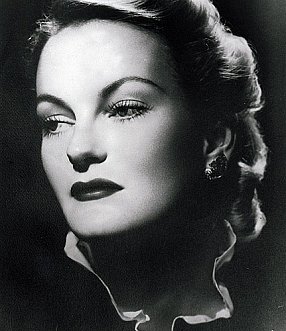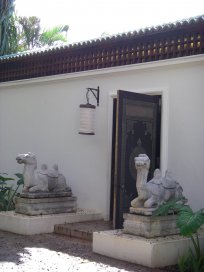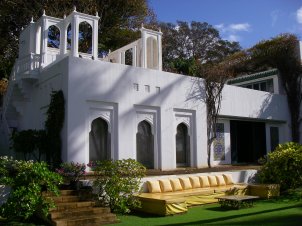Graham Reid | | 7 min read

At the end of her sometimes scandalous life, the American heiress and socialite Doris Duke was unlikely to go into that great goodnight without some attendant controversy -- and she didn’t disappoint.
When she died in at age 80 in 1993 at one of her homes -- the so-called “Falcon’s Lair” in Beverly Hills which had belonged to Rudolph Valentino -- she left her billion dollar fortune to her charitable foundation. The catch was it would be administered by her loyal butler Bernard Lafferty, a gay Irishman often described as a drunkard and semi-literate.
There were persistent allegations -- although Duke had suffered a series of strokes -- that “the butler did it” because the protective Lafferty, who kept family and friends away in the last years of Duke’s life, was at her bedside, and she was cremated within a day.
But long before speculation about her death was Duke’s singular life: she inherited a fortune at age 12 and was dubbed by the press “the Million Dollar Baby“; had two brief, high-profile marriages and serial lovers; and in 1988 at age 75 she adopted a 35-year old former belly-dancer and Hare Krishna devotee with whom some believed she was in a lesbian relationship. Always conscious of her looks, she had a facelift at 79.
With colourful locations, money to fritter and the cast of 20th century public figures, Duke’s life could be read as a script for a brash movie.
And indeed there is a film made about her final days, Bernard and Doris starring Ralph Fiennes and Susan Sarandon.
Certainly the breadth of Duke’s life -- alleged affairs with actor Errol Flynn, Hawaiian surf champion and Olympic swimmer Duke Kahanamoku, and General Patton among others -- was made for the motion picture screen. But as Norma Desmond observed in Sunset Boulevard, the pictures got small.
And Doris Duke’s life was big.
Aside from gossip, lovers and a fortune, Duke left a more publicly tangible legacy -- her home on the Hawaiian island of Oahu near Waikiki Beach which she built in the late Thirties. In recent years it has been opened to small groups of visitors.
Few tourists who hit the bars, beaches and aloha-shirt shops on Oahu make it to Duke’s oceanfront house. It is under-publicised and only 12 visitors at a time are allowed entry on four days a week. The curious must book in advance.
Shangri La, as she called it, is all but invisible as you come down the driveway to the main entrance which is simply wooden doors in a white, windowless wall. Only the two stone camels from China at the entrance hint at the pleasure palace within.
Duke -- who owned homes and apartments in New York, Rhode Island and Los Angeles, as well as a farm in New Jersey -- considered the five-acre property her retreat.
“Doris Duke liked her privacy,” says Charles, the softly-spoken guide who is showing just two mainland couples and me around on this typically warm day. “You will have noted that when you came down the driveway, this is a very private house.”
Even when seen from passing boats little of Shangri La reveals itself, its discreet low lines offer no hint of its inner opulence or overtly announce its unusual contents.
What makes Shangri La so interesting is that -- as with William Randolph Hearst’s mountain-top aerie in California -- it is a monument to unconstrained wealth, eclectic taste, restless acquisition and eccentricity.
However unlike Hearst’s baroque conflation of architecture and art from all over the globe, Duke’s oceanfront home -- with a stunning view of Diamond Head -- has a more singular focus: it is a spacious and sometimes elegant mix of Islamic art and design.
Stepping through that wooden door inscribed in Arabic “enter here in peace and security” you walk into a world which is lavish yet minimal.
Over there are 17th century ceramic tiles from Turkey, down there in the inner courtyard around the fountain are some from 13th century Iran, here a light fixture from Syria and there a mosaic made by Duke in 1938 based on Iranian arabesques.
Through here is the enormous living room and note how, whispers Charles, that although this house is rooted in the past and other more exotic places, Duke utilised modern technology of her time: that glass wall of maybe 12 metres in width and perhaps five metres high can slide down into the floor at the push of a button.
Now you have an unimpeded view of Diamond Head beyond the Olympic-size pool where Buster Crabbe and Johnny Weissmuller once swam.
In her will Duke bequeathed this place to her foundation to “promote the study and understanding of Middle eastern art and culture”.
But Shangri La is evidence that Duke didn’t curate, she decorated. And this was a home not a gallery. Duke saw what she liked, bought it and then placed it where it suited her. Although it draws on Islamic art -- whatever that might mean given the diversity of it through various countries -- there is no consistency.
One large mosaic of illustrative tiles is placed on a wall sideways because it better suited the view down the hallway. The undeniably beautiful 13th century mihrab -- a wall niche indicating the direction of Mecca -- rather than facing northwest is on an eastern wall. To her it simply looked better there.
Elsewhere separate centuries and styles are juxtaposed.
And in it’s heyday Duke had Hawaiian nick-knacks and household objects -- hula-girl shot glasses, surfboards and the like -- around the place. This was a home to be lived in, not admired with the objective eye of a scholar.
Her collection of some 3500 items is where the real treasure for a scholar might lie, but to peruse those you need special permission.
However Shangri La, just as any home which bears the bold fingerprint of its occupants, rewards a visit on its own terms -- and she certainly had a bottomless well of money to create it.
Doris’ father James “Buck” Duke made his millions from tobacco, property and energy companies and when he died in 1935 she inherited the majority of his estate. It was, when paid in full, something more than a billion dollars in today’s money.
The young Doris was by all accounts a smart and intelligent child, and although her wealth allowed her to indulge various passions such as a love of animals, the arts and travel, she was far from frivolous with her money. As her third cousin Pony Duke noted, “She didn’t have hobbies, she had obsessions and she turned all her interests into businesses“.
She made large donations to charities, but also took care of her own increasingly rapacious desires.
On marrying James Cromwell in 1935 the couple went on a lengthy honeymoon which took them to, among other places, India where she fell in love with the Taj Mahal. She immediately commissioned a marble bedroom based on designs and motifs of that exotic tomb. She intended to have it constructed in the couple’s Florida home.
The final stop on their 10-month honeymoon was Hawaii. The relaxed pace and tropical climate won her over and she and James stayed four months. Plans for the Florida home were put on hold and she began to conceive of a retreat on the picturesque property at Ka’alawai which she purchased.
And so, with more than 100 local workers and from designs by the architect Marion Sims Wyeth, building began and the home was occupied in late 1938.
She used Shangri La -- named for the Utopian kingdom in James Hilton’s pre-war escapist novel Lost Horizon -- as a seasonal retreat, more so after she and James divorced in 1943.
Although she was busy with the house Duke also had time for life: she was briefly married to the notoriously well-endowed playboy-cum-diplomat Porfirio Rubirosa; entertained herself with travel, alcohol and drugs; played jazz piano; and enjoyed numerous lovers, parties and famous guests.
When on the island she surfed competitively and for pleasure -- and pleasure, especially of the sexual kind, was something she knew well, as a few salacious biographies attest.
Charles, our guide, is circumspect to the point of looking dyspeptic when I ask whether there is a thorough biography of Doris Duke. He leaves us in no doubt that bad press and innuendo about Duke remains outside those wooden doors.
He does note however that late in life she had fewer and fewer friends call, although he doesn’t mention Lafferty’s part in keeping visitors out.
As her health deteriorated the fiercely loyal, binge-drinking, barefooted and pony-tailed Lafferty -- who took to wearing Doris’ designer dresses after her death and cruising gay clubs in Los Angeles -- ensured the former society queen was kept in something approaching seclusion.
At the end she was left with Lafferty, her beloved dog and, at Shangri La, the strange collision of eclectic Islamic décor in a European modernist building on a balmy Pacific island.
When the house was nearing completion in 1938 a reporter for the Honolulu Star Bulletin wrote: “On all the face of the globe there is no other place like it, nor is there likely to be.”
And at the time Doris Duke hadn’t even brought in most of the Islamic décor -- or the pet leopard.
.










post a comment